Canadian Forces Provost Marshal Annual Report 2021-2022
Canada's Military Police
Highly skilled soldiers and police officers serving in Canada and abroad
Office of the Canadian Forces Provost Marshal and Military Police Group
2200 Walkley Road
Ottawa, ON, K1A 0K2
Telephone: 613-949-1000
Fax: 613 949-1637
Catalogue No. D3-13F-PDF
ISSN 2561-8490 (Online)
Message from the Canadian Forces Provost Marshal and Commander of the Canadian Forces Military Police Group
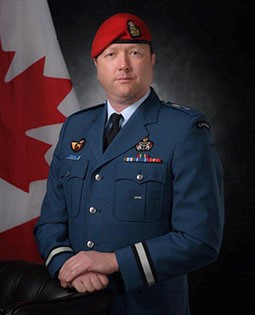
As the Canadian Forces Provost Marshal (CFPM) and Commander of the Canadian Forces Military Police Group (CF MP Gp), it is my pleasure and statutory duty to present an annual report that will account for the Military Police (MP) activities and accomplishments that occurred between 1 April 2021 and 31 March 2022. This report highlights the many ways in which our MP personnel provide professional policing services to the Canadian Armed Forces (CAF), but also the many specialist functions that MP carry out, such as providing close protection services to high value strategic assets, and securing airfields on Operation (Op) AEGIS in Afghanistan. This report also provides a detailed update on the advancement of our five-year strategic plan and on more recent initiatives such as the work of our maturing analytics section, among other areas of interest to the Defence community and the Canadian public.
The last fiscal year has undoubtedly been both eventful and productive for the MP. We have continued to provide highly skilled policing, security and detention services for the CAF, while our MP made contributions to major military operations such as emergency evacuations in Afghanistan and relief efforts during the floods in British Columbia.
I was particularly impressed by the quality of our Canadian Forces National Investigation Service (CFNIS) investigators’ work. They conducted an unprecedented number of sexual misconduct investigations, resulting in criminal code charges and convictions pronounced by civilian court of public interest cases. Throughout this turbulent period, we demonstrated our professionalism as an independent police service.
Twice this year, I appeared before the standing Committee on the Status of Women (FEWO) and delivered several technical briefs to a wide array of stakeholders about the report tabled by the Third Independent Review Authority.
These experiences gave me a privileged opportunity to reflect on some of the most fundamental aspects of our work and its purpose in a democratic society. I listened and took to heart the tough questions and valid issues raised. I am both humble and proud to report that we have consequently adopted policies and training that bring tangible improvements such as “Using a Trauma Informed Approach” and “Victims’ Rights in Canada” courses.
Since October of 2021, one of my main areas of focus has been implementing Madame Arbour’s recommendation to transfer jurisdiction for sexual assault and other criminal offences of a sexual nature under the Criminal Code to civilian police agencies. Putting a comprehensive process in place across Canada will take time, but cases have already been transferred and new cases are being referred in some jurisdictions.
We are a learning organization. Therefore, we will continue to adjust and improve in light of the observations, findings and recommendations issued by external review bodies.
I am gratified of the way in which we continue to recruit and train, but also how we continually evolve and modernize. We will implement Bill C-77 and its Declaration of Victims’ Rights (DVR), which will better serve victims in the decades to come. This evolution is making us stronger. We are also adopting practices that make our organization more efficient and modern. For example, we have increased the number of green vehicles in our fleet, we are digitizing police reports to improve efficiencies in our Access to Information section and we successfully procured, developed policy, trained and deployed the Conducted Energy Weapon (CEW) domestically in the fall of 2021.
In January of 2021, we launched Operation UNITY, a six-year undertaking seeking to institutionalize a permanent Close Support MP Capability in the MP Reserves. In line with the strategic intent of the Chief of the Defence Staff (CDS) of providing “full-time capability through part-time service”, this initiative is well underway.
These policy and technical advancements are no small feat to undertake and implement, yet we continue to move forward and improve the quality and efficiency of our operations year after year.
As I reflect on the year 2021-2022, what strikes me as most impressive is the dedication and professionalism with which all MP members undertook many monumental tasks and overcame numerous obstacles. In doing so, they ultimately contributed to the safety, effectiveness and readiness of the CAF.
Today, more than ever, I am proud of this unwavering and inspiring team.
Sincerely,
S. Trudeau
Brigadier-General
Canadian Forces Provost Marshal
Commander of the Canadian Forces Military Police Group
Message from the Canadian Forces Military Police Group Chief Warrant Officer
A CF MP Gp Chief Warrant Officer Change of Appointment was held on 15 November 2022 as CWO Martin Rousseau concluded two-years of exemplary service with the CF MP Gp. Despite the challenges and complexities associated with providing institutional leadership to over 2000 serving members and their families spread across Canada and in foreign countries, CWO Rousseau received nothing short of praises for accomplishing his duties with brilliance.
I sincerely thank CWO Rousseau for his leadership, guidance and mentorship to all members and personnel of the CF MP Gp.
This was a challenging time for the entire CAF to serve at home and abroad in a global pandemic environment, however the professionalism and resolve of the entire CF MP Gp team of regular and primary reserve forces, public service employees and contractors was impressive. As a team they maintained constant readiness to support missions, operations, and institutional tasks in line with the strategic goals and ever adjusting priorities of the CAF and CF MP Gp. Achieving this would not be possible without the extraordinary devotion of our members. Several members were honoured throughout 2021-22. This included a CDS Commendation, two Vice Chief of the Defence Staff (VCDS) commendations, two from the CJOC, two by the Canadian Forces Intelligence Command and three from the CFPM.
As an intrinsic part of the CAF, we participated in strategic level discussions covering the implementation of culture change and diversity. At the MP Council, I briefed on the way ahead and how we must improve as a team player in the CAF in every aspect of what we do moving forward, I look forward to hearing from members at the unit level and welcome discussions and feedback on how we are progressing with culture change or any other topic of concern about our organization.
The Next Generation MP Operational Dress (NGMPOD) survey was a constructive step in updating the MP operational dress. As a result, proposals with specific design feature for MPs while maintaining MP accoutrements and display of clear police identifiers on all dress were presented to the Comd of the CF MP Gp.
In closing, I would like to express that I’m looking forward to meeting and discussing with members of the Defence Community throughout my time as the CF MP Gp Chief. I’m already impressed by the level of professionalism demonstrated by all our team members whether at home or abroad as a modern and relevant police force.
Mission, Vision, MP Values and Core Functions
Mission
The CF MP Gp provide professional policing, security, and detention services to the CAF and DND globally, across the full spectrum of military operations.
Vision
CF MP Gp will generate and sustain a credible and professional MP force properly resourced and enabled to conduct operations in the joint, combined environment through the implementation of its assigned mission and core functions.
Values
MP are expected to conform to the standards established in the MP Professional Code of Conduct (MPPCC), which embraces the following values:
- Loyalty;
- Accountability;
- Integrity/Ethics;
- Competence; and
- Pride/Professionalism.
Core Functions
- Policing;
- Security;
- Detention; and
- Operational Support tasks for Environmental Commanders.
Structure and Jurisdiction
Structure/Independence
The CFPM is appointed by the CDS and is the functional authority for MP within the CAF and the designated advisor to the CDS on policing matters. The person assigned to the position of the CFPM is also charged with the command of the CF MP Gp and exercises full command over all MP personnel independently from the chain of command (CoC) when performing police duties and functions.
The changes to the MP command and control structure in 2011 was a proactive measure by the CAF designed to strengthen the Military Justice System. This revised structure reinforces the independence and the authority of the CFPM in the exercise of the policing mandate.
As the centralized MP Headquarters (HQ), the CF MP Gp HQ provides direction to all MP members with regards to police policy and procedures, oversight on policing and security matters, professional standards, security, equipment and training, as well as broader MP Branch activities and traditions.
Jurisdiction
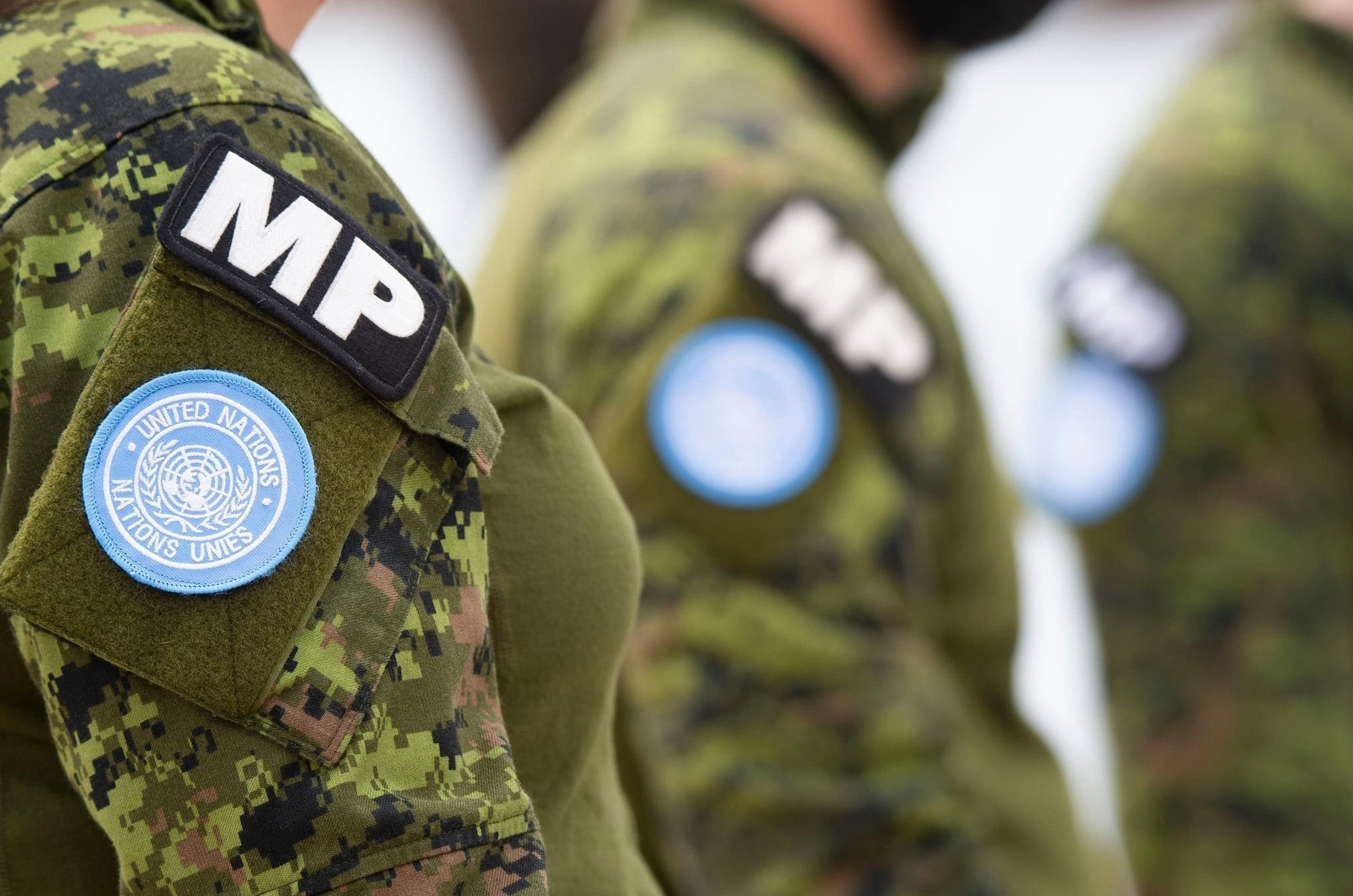
The CF MP Gp is among the 10 largest police services in Canada and fulfills national policing responsibilities. MP routinely exercise their unique jurisdiction within Canada and all locations where the CAF are deployed around the world.
On operations outside Canada, MP enforce Canadian criminal law and military law with respect to members of the CAF and other persons subject to the Code of Service Discipline (CSD). Within Canada, in many instances, the MP share concurrent jurisdiction with civilian police.
In the enforcement of Canadian military and criminal laws, MP are peace officers and lawfully exercise jurisdiction over members of the CAF and over persons on defence establishments including civilians. As first responders, MP have a key and important leadership role in safeguarding our Bases and Wings.
Office of the Canadian Forces Provost Marshal
Professional Standards
The Office of Professional Standards (PS) for the CFPM was established in 1997. This team of nine military and civilian personnel report directly to the Deputy Commander of the CF MP Gp. The mandate of PS is to carry out administrative investigations in respect to conduct that is inconsistent with the professional standards applicable to MP or the MPPCC. In doing so, PS continues to enforce accountability for credentialed MP. As with any civilian police force, the conduct of MP personnel is critical to maintaining the trust of those they serve. Anyone can file a complaint with the MP PS. The Office of PS does not conduct investigations into alleged criminal/service offences.
The Office of PS also manages the MP Credentials Review Board (MPCRB) process. The MPCRB is convened, upon requirement, to deliberate any MP conduct which allegedly breaches the MPPCC and is serious enough to question the suitability of that MP to maintain their MP credentials. In FY 21-22, there were 30 referrals to MPCRB.
This fiscal year, PS received 47 complaints from the public about the conduct of MP. PS also opened 75 internal files which are reports from the MP CoC in regards to MP actions which could be potential breaches of the MPPCC.
Military Police Analytics Program
Law enforcement agencies collect vast quantities of data in their response to incidents and the resulting search for answers through investigation. Data Management and Analytics (DMA) is focussed on the organization and analysis of this information, in such a way that it can support evidence-based decision making at all levels of the institution. The main driver of analytics is the Military Police Analytics Program (MPAP), which provides support to the MP and clients within the CAF, to the Department and to Government. The two most important deliverables are the Departmental Results Report (DRR) and the Statistics Canada (StatCan) Uniform Crime Reporting (UCR) Survey.
Military Police Information Release Section
The Military Police Information Release Section (MPIRS) has already made significant progression in the long awaited conversion of the police investigation files from microfiche to pdf format. The collection of investigation files date back to 1947 and are accessed frequently due to Access to Information (ATI) requests from several different departments. These ATI requests can be very time consuming to complete, as the microfiche have to be located, loaded, and searched manually to find the information requested. The conversion of the investigation files will see them converted into searchable pdf documents stored on new external hard drives that will greatly shorten the turnaround time to complete the requests thereby improving CF MP Gp’s response.
Military Police Legal Services
In 2021, the MP Legal Services supported the CF MP Gp in a year of change. The focus of the MP Legal Services was divided between supporting the production of policy for incoming changes, and continuing to work with the CF MP Gp in their response to the various external reviews affecting the military justice system (MJS). This included the work on implementing recommendations from the Third Independent Review of the National Defence Act (NDA), responding to the ongoing external review of the CAF, conducted by Madame Arbour, as the External Review Authority (ERA) and implementing an important interim recommendation Madame Arbour had issued in the fall of 2021.
The CF MP Group has also been preparing for the significant changes that will occur when Bill C-77 comes into force in the summer of 2022. To this end, the MP Legal Services have supported the creation of policy required to be in place at the coming into force date.
More specifically, the MP Legal Services team welcomed the multifaceted challenge to prepare for the coming into force of the DVR, which involves statutory changes as well as the implementation of key recommendations issued by Justices Fish and Arbour.
From an operational policing perspective, the CF MP Gp was preparing for the introduction of the CEW, which required research and advice in the promulgation of the new use of force (UoF) orders.
Concurrently, the MP Legal Services were heavily involved in the generation of updated academic material subsequent to the implementation of the recent Military Employment Structure study of the MP trade as the Canadian Forces Military Police Academy (CFMPA) initiated an in depth review of all its career courses.
Highlights
MP provide professional policing and security services to CAF Operations
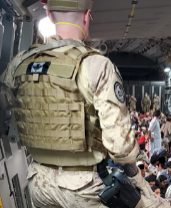
Operation (OP) AEGIS – MP specialized as Aircraft Security Officers (ASO) played an incredibly important security role during OP AEGIS. From the ground at Camp Canada, Kuwait to onboard Royal Canadian Air Force (RCAF) aircraft, MP expertly provided over-watch protection of the evacuees, the aircraft and its crew.
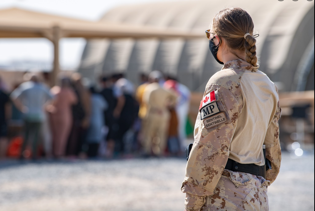
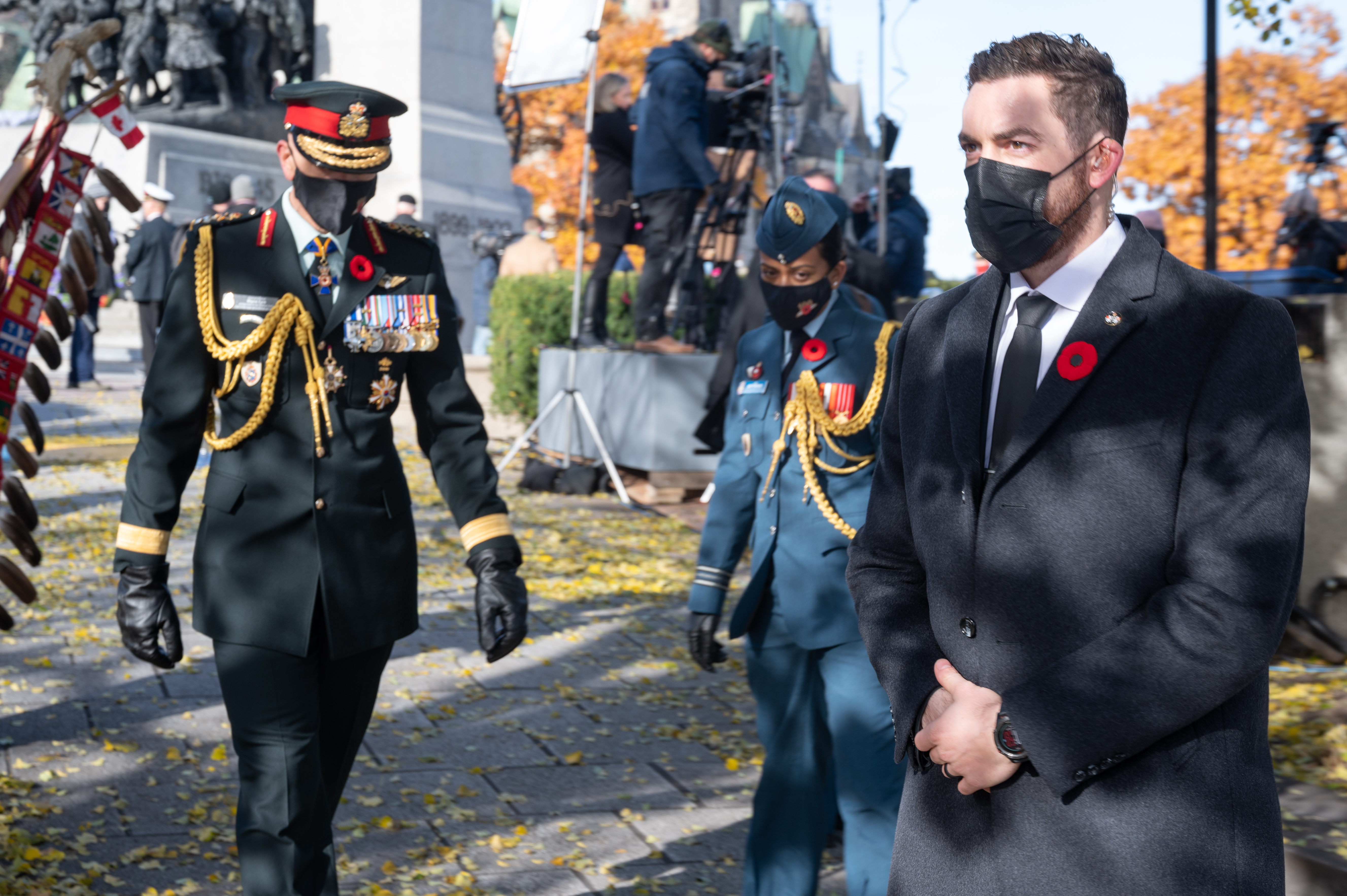
The Canadian Forces Protection Services Unit (CFPSU) had a very busy year conducting 34 international missions and 40 domestically, involving a total of 1561 personnel days.
The CFPSU is a high-readiness, specialized unit that provides expert protective services capable of conducting a broad range of special protective missions and tasks in support of the DND/CAF at home and abroad. Protective services is the enhanced level of protection provided by specially trained individuals to high value strategic assets that are under specific or general threat. Protective services may vary from a security advisor up to and including the dedication of a full scale Close Protection team.
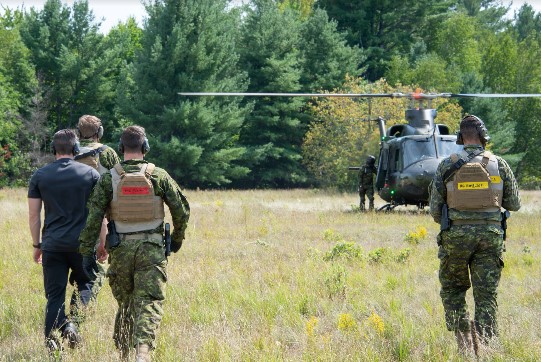
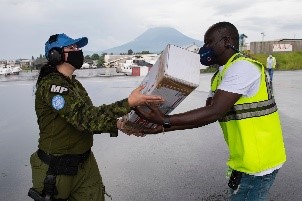
Op PRESENCE – MP specialized as ASO deployed in support of the United Nations (UN) were photographed by Combat Camera on location as an uploading evolution was conducted of a CC-130J Hercules at the Tactical Air Detachment Goma, operating at the Entebbe International Airport, Uganda.
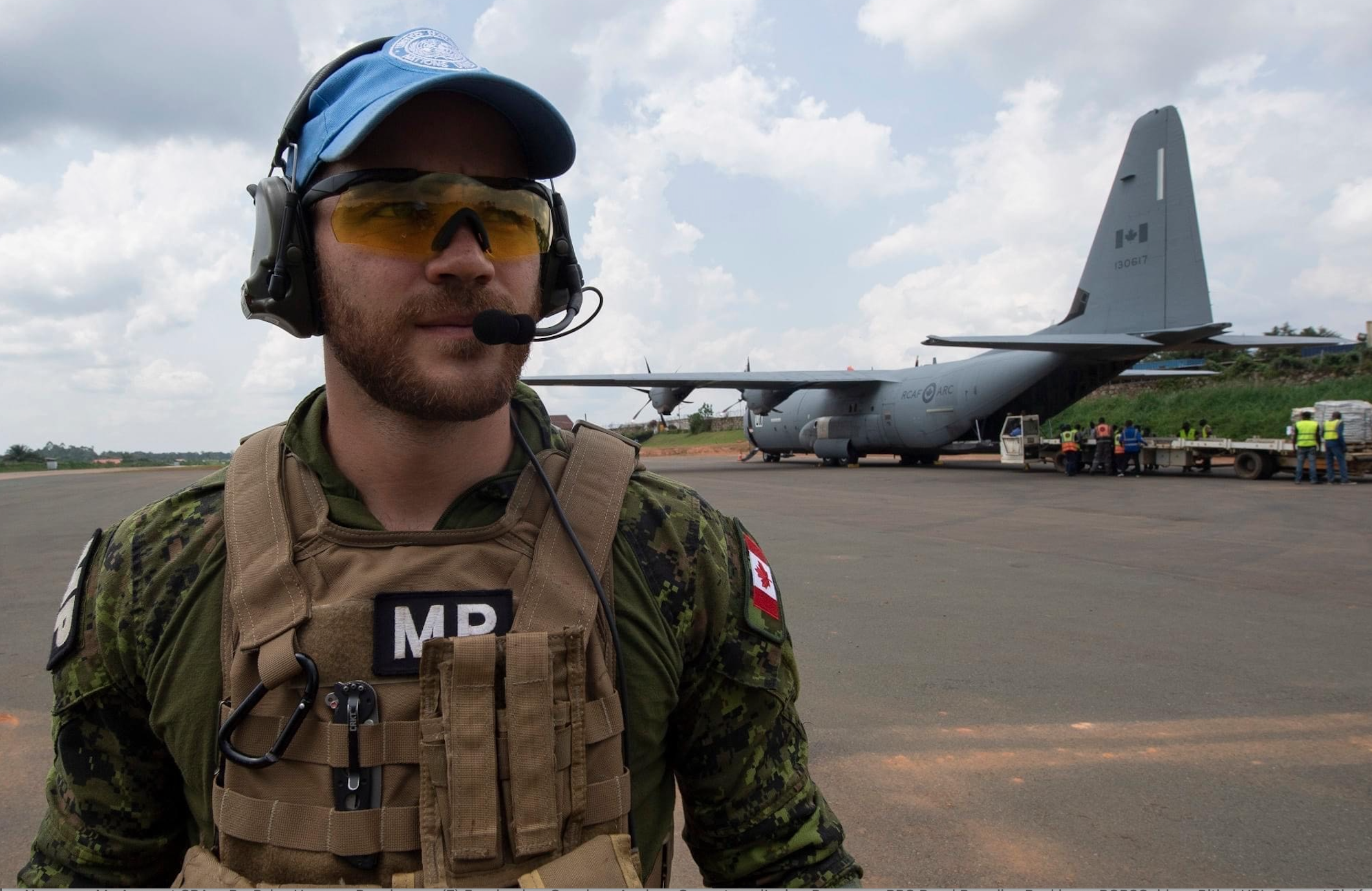
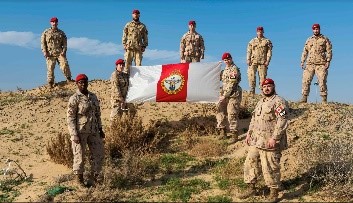
Op IMPACT – From policing support and security advice, to reviewing physical security standards, deployed MP members also helped raise spirits of sick kids in regional hospitals across Kuwait and Jordan through Operation TEDDY BEAR.


Meanwhile, also on Op IMPACT in Kuwait, Capt Michael Andrade with the MP Unit in theatre raised funds for the MP Fund for Blind Children as he ran dressed as a superhero. “I run for the kids, because if they can keep their optimism despite all the challenges they face, the least I can do, is grind it out till the end of tour running in superhero shirts to make people laugh and bring some light if someone is having a bad day,” expressed Capt Andrade.

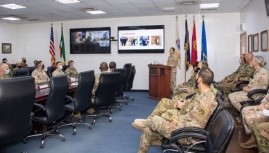
Recognition – Cpl Megan Bickford was recognized for an outstanding performance as a member of the MP Unit of JTF-I/TF-C. The ‘Hometown Hero’ award was presented by the United States 387th Air Expeditionary Group Commander, Colonel Joshua Pyers at Ali Al Salem Air Base in Kuwait.
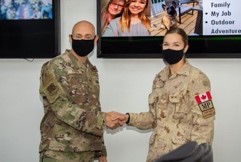
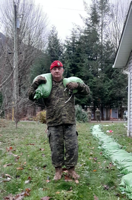
Op LENTUS – Domestically, MP actively engaged by conducting mobility support for D Squadron of the Lord Strathcona’s Horse (Royal Canadians) operating in the Chawathil First Nation community. MP helped sandbagging with the rest of the task force to protect community homes, conducted access control at the main gate to the Vernon Cadet Camp and ensured traffic control for engineer road work.
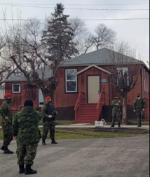

Representation in the Community – Building awareness and trust as professional CAF members and law enforcement officers, MP participate in activities and community events across Canada to raise money for charities and build relationships in the communities they serve. MP also do their best to encourage safety habits and practices within the Defence Community and reward those who show initiative through the Positive Ticket Program.

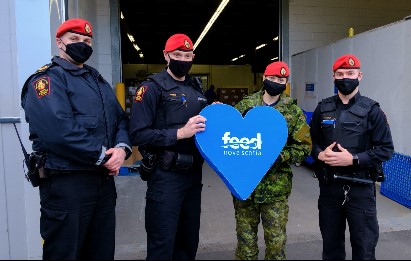
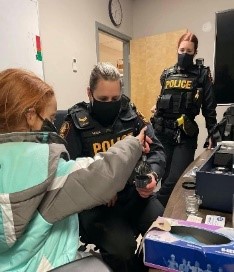
Inspirational – After finding out Mrs. Boneschansker’s eight-year-old daughter Taelynn was informed that policing was not a career suited for women, Cpl Muise, from 22 MP Flt in North Bay, took it upon herself to lift Taelynn’s spirit and prove otherwise. Cpl Muise invited Taelynn and her mother to 22 MP Flt for a meet-and-greet with herself and Cpl McAughey.
A tour of the MP detachment was provided along with some fun activities, such as learning to fingerprint with a forensic kit and sitting in the front seat of a patrol vehicle. Both MP shared their stories about how they came to be MP members. Taelynn was presented with a ‘trauma bear’ as a gift from 22 MP Flt.
“We hope that these independent actions proved to Taelynn that no matter what she may be told, she too can follow her dream and one day become a police officer or whatever she aspires to,” expressed Cpl Muise and Cpl McAughey.
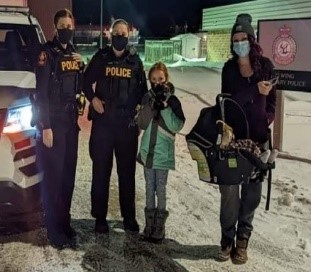

Public Recognition – Cpl Ronalyn Haustein-De La Cruz received the CAF player of the game, at the Halifax Mooseheads Quebec Major Junior hockey League game on 11 November 2021. She was presented with a jersey and a standing ovation for her exceptional efforts and being an invaluable MP member at MP Unit Halifax.
MP partake in innovative and unparalleled exercise formats
REDCAP PARTNERSHIP 1 – In November 2021, MP representatives from Canada, the USA and the UK met online to reinvigorate interoperability activity among MP forces around the word. The objective was to enhance joint operational effectiveness.
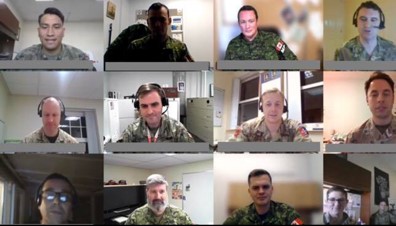
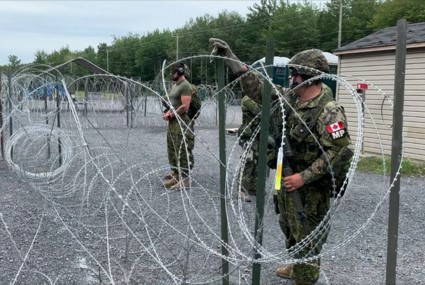
WATCHDOG CHEVRONNÉ– During the summer of 2021, in Farnham, Quebec QL3 and QL5 reservists from the 4th Company of the 5th MP Regiment took part in Exercise WATCHDOG CHEVRONNÉ. The exercise validated skills and knowledge to serve as a Field MP within a brigade.
“They were exposed to real-life scenarios for both mobility and detention operations,” said Captain Sylvie Delisle, 4th MP Coy in charge of coordinating this exercise.
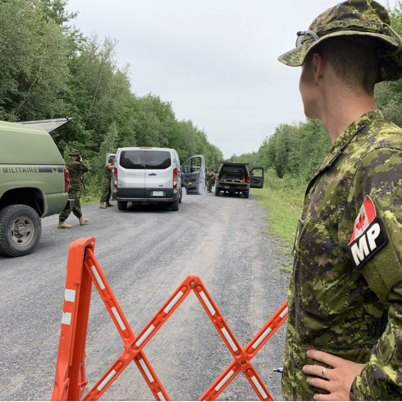
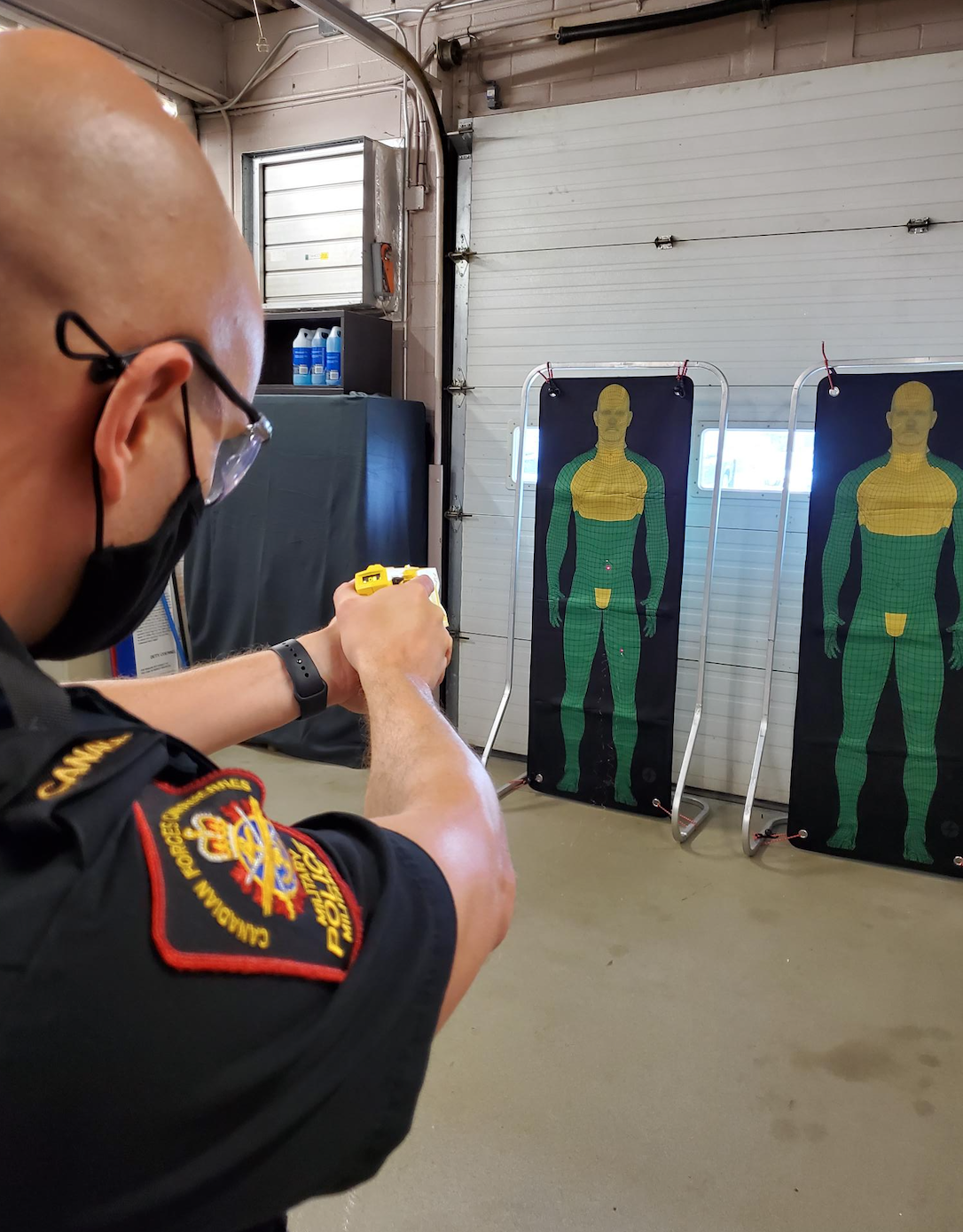
Rollout of Conducted Energy Weapons (CEW) – In the fall of 2021, MP personnel across Canada were fully trained and equipped to carry the CEW, commonly known as the Taser. As part of modernization initiatives, this capability provides MP with an alternative ability in gaining control of a subject in situations where the subject is assaultive, or where there is an imminent threat of serious bodily harm or death. While never to be used as a substitute for de-escalation, the addition of the CEW adds flexibility to employ an applicable level force to successfully resolve an altercation while securing the safety of MP personnel and anyone being protected by them.
Military Police Strategic Plan 2019-2024
At the end of fiscal year 2018-2019 the CFPM put in place a five-year strategic plan to be executed from 2019 to 2024. The purpose of the plan is to outline the major initiatives that will be implemented to ensure a healthy and well balanced force that can deliver an efficient and effective MP program within DND/CAF.
The MP strategic plan 2019-2024 continues to provide a solid foundation to guide the current and future priorities of the CF MP Gp. Next year, we will see the development of the next strategic plan 2024-2029 which will build on its current success.
The Capability Development Committee (CDC) continued its work in the synchronization of MP led initiatives. It was supported by its three sub-committees which began to work on priorities assigned by the CDC. The Force Development (FD) sub-committee provided the final coordination required to complete the implementation of the CEW to include the collection of lessons learned as well as to begin to look at possible capability deficiencies in the Immediate Action Rapid Deployment (IARD) program. The emerging technology sub-committee worked on establishing research resources and began identifying future capabilities of interest such as Small Unmanned Aerial Systems (SUAS). Finally the doctrine and training sub-committee began looking at the doctrinal organisation required to support commitments as well as conceptualize how best to employ the new judgement training simulator.
Additionally, the CF MP Gp will reap the benefits from MP attending the Canadian Army Technical Staff Programme during the academic year 21-22. The Captain and Warrant Officer who complete the course will be posted into the FD cell where they will be able to apply their newly acquired knowledge. This bolstered FD cell will be postured to make great progress on the modernization of MP equipment and technology.
Update on the Five Main Priorities in the Strategic Plan
Domestic Policing and Force Structure
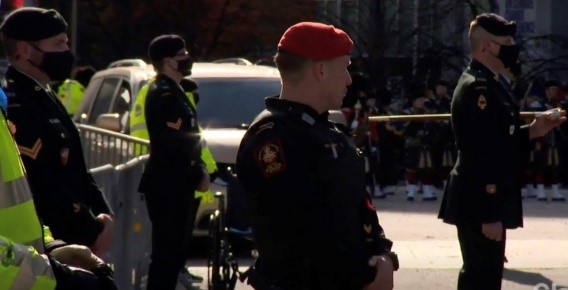
Over the past several years the CF MP Gp has been studying how to right-size domestic policing across all DND locations. These studies endeavoured to ensure that the appropriate MP personnel resources are assigned to each MP Guardhouse across the country. Previous studies recommended three-sized detachment models based on factors such as historic policing requirements, police files (General Occurrences), detachment population and several other data points. The latest, and final study, known as the Domestic Police Establishment Project (DPEP), incorporates the results of the previous studies with new data which revealed CF MP Gp guardhouse supported an additional 47 Person-Years of Force Generation (FG) tasks in support of CJOC and supported Commands.
Throughout 2021, work continued on a Master Implementation Plan (MIP) to enact the wide reaching recommendations of the DPEP. The MIP draft is now complete and set to be approved summer 2022.
The execution of the MIP will commence with the 2022 posting season and, in order to take into account personnel realignment and ultimate posting movements, it is expected to take five years to fully implement. In addition to standardized and equitably resourced guardhouses, the MIP will offer the CF MP Gp several administrative improvements, including: a common architecture for real property projects; a means of forecasting materiel demands; a tool assisting career managers and branch advisors in determining postings; assisting MP operations in assigning tasks across the entire group; and providing the Commander flexibility in assigning personnel resources among the group.
Health and Wellness of the Force
The CF MP Gp continued to invest in the health and wellness of the force. The MP BALANCE online tool, which operationalizes the CAF BALANCE physical performance strategy, has migrated to its new home on the Defence Learning Network (DLN). It will be accessible to all members of the CF MP Gp with the launch of the new DLN platform. Meanwhile, the scope of the standing committee on Health and Wellness has expanded to incorporate social wellness, inclusivity, and culture change. A new equity and diversity sub-committee will synchronize programs, provide a forum for diversity ambassadors and advise on the progress the group has made in improving the health of our work environment. The sub-committee will be gathering data from group listening sessions in order to incorporate these lessons into its program, further aligning it with the CAF’s new Total Health and Wellness Strategy.
MP resiliency training has continued its progress throughout the pandemic. The Road to Mental Health and Readiness for Military Police (R2MR4MP) has been fully integrated into all MP career training, and gap training fully integrated into all MP career training, which remains an important cornerstone of the CF MP Gp strategy to encourage psychological health and safety. Next steps include beginning to look at options to expand the program to include annual refresher training in order to ensure that resiliency is a daily practice that enables our personnel to manage the stress of a military and policing career.
Data Management and Analytics
Over the past year, the MPAP has brought the MP into compliance with the requirements of the Statistics Act, providing quality assurance to field-generated UCR Survey data. Validated data is then reported regularly and consistently to the Canadian Centre for Justice and Community Safety Statistics (CCJCSS). Achieving regular submissions to StatCan also provides a further opportunity for external validation of data. It is the UCR Survey that provides the backbone from which the MPAP can build analytical products that support business intelligence, and to provide commanders/leaders across DND/CAF with situational assessments concerning crime, criminality and social issues. The survey data is also used extensively in the development of criminal intelligence products by the Military Police Criminal Intelligence Section.
MPAP has also continued to develop its relationship with Defence Research and Development Canada (DRDC) to offer clients within DND/CAF more comprehensive, customized products to address priority requirements, such as data analysis supporting the Independent External Comprehensive Review.
The maturation of DMA and diversification of analytical products is expected to foster a data-driven culture that will positively influence decision making in aspects of business, whether client-facing or inward facing. Being able to quantify challenges, and prioritize resources should see improvements in all areas, from resourcing units actively conducting investigations, to strategic decisions on equipment, readiness and infrastructure.
MP Reserve Optimization
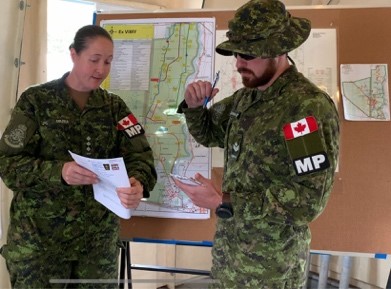
The MP Reserve is comprised of four Close Support MP Companies (11 Reserve MP Platoons located in Canada’s major urban centres) under command of the four MP Regiments that comprise the Army MP Group, and one General Support MP Company under command of CF MP Gp HQ.
Over the last decade it has become apparent that the Reserve MP training model and an inconsistent assignment of mission and tasks has led to reduced operational output. Concurrent to this realization, the CF MP Gp has had to react to the CAF’s strategic initiatives of Force Mix Structural Design (FMSD), and most importantly the Strong, Secure, Engaged (SSE) Defence Policy.
CF MP Gp is entering the second year of Op UNITY, a six-year undertaking to leverage the MP Reserves for the purpose of institutionalizing a permanent Close Support MP Capability across the full spectrum of operations both domestically and abroad. This undertaking will address a significant transformation of the individual training that Reserve MP will receive in addition to a deliberate focused approach to assessing, measuring, and validating collective Close Support MP Capability. It will have a transformative effect upon how the CF MP Gp trains for the purpose of executing its non-law enforcement tasks for the CAF’s supported Commanders.
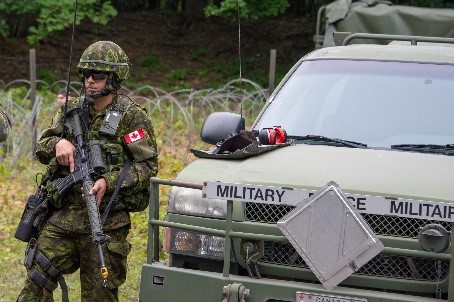
The future of the MP Reserve will be completely in line with the CDS strategic intent in that the CF MP Gp will ensure it is fully capable of providing “full time capability through part-time service” as stated in the SSE.
Modernize MP Equipment and Technology
The CF MP Gp is continuing to develop and perfect its FD capability. This is being carried out in concert with the CDC to help with governance of this key long-term strategic activity. FD is an integral part of the business planning and operational planning cycles. This process ensures that the CF MP Gp can be forward thinking and make best use of both in-year and out-year resource allocation.
MP equipment needs are divided into four (4) major areas:
- Soldier Systems – all equipment worn by the MP;
- Mobility – all vehicle related equipment;
- Command, Control, Communications, Computers (C4) – tactical communications, information management equipment and digital assets; and
- Infrastructure – all MP related permanent and temporary infrastructures used to house and support MP operations domestically.
I. Soldier Systems
Enhanced Body Armour – Successful roll out of this capability occurred this year with most MP now having been issued their new enhanced soft body armour. Ongoing coordination is being done with the item manager to ensure sufficient stock is maintained.
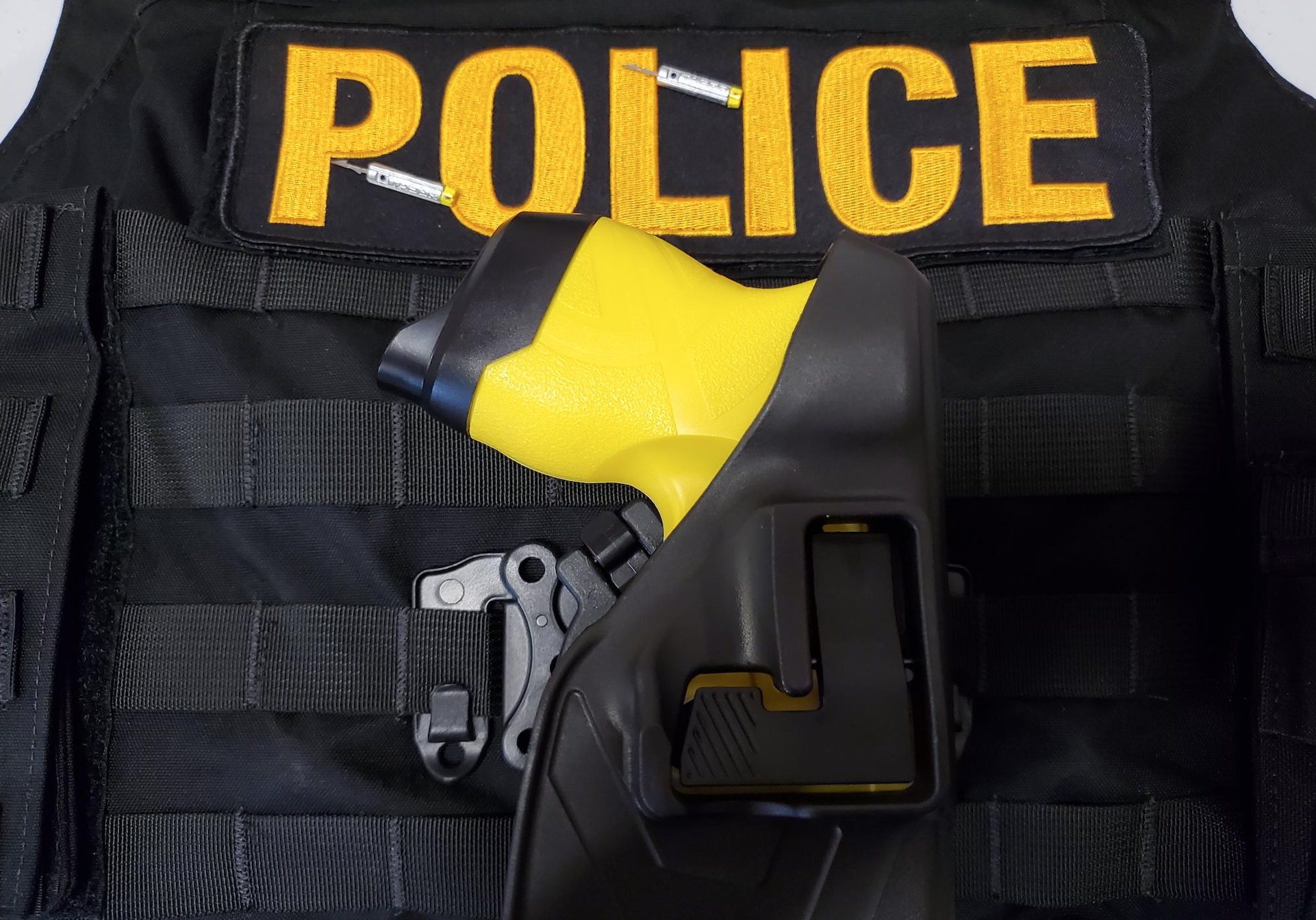
Conducted Energy Weapons (CEW) – The policy work to include laser safety as well as training requirements was completed prior to a successful implementation in the fall of 2021. MP units have achieved Initial Operational Capability (IOC) with MP personnel carrying CEW on daily patrols. Work has begun to equip field platoons with this capability to ensure the same level of service can be offered during domestic operations. Final Operational Capability (FOC) is still planned for 2024.
MP Service Pistol Modernization – The project still resides with Assistant Deputy Minister (Material) (ADM(MAT)) and is expected to move forward with contracting for 2500-3500 pistols during FY22-23 and FY23-24. Delays on this project were due to a Canadian International Trade Tribunal decision related to the Canadian Army pistol project.
Next Generation MP Operational Dress (NGMPOD) – Following the analysis of the information collected during a survey, a brief outlining different options was delivered to the Commander of the CF MP Gp. Work on the statement of requirement (SOR) has begun which considers gender based analysis and advice from those who wear operational dress on a daily basis. The results of the survey and overlapping information with Directorate of Soldier Systems Project Management (DSSPM) will ensure that the updated MP Operational Dress will meet the needs of CAF members who specialize in MP operations. We expect new sample uniforms to be trialed during FY23-24 and FY24-25.
II. Mobility
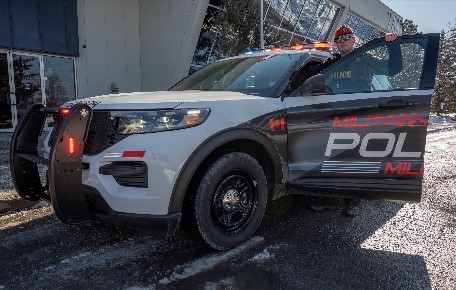
New MP vehicle decal design. Under the modernization project, the new patrol vehicle decal is a result of an extensive consultation process involving input from members of the MP Group. The new branding aims at better identifying MP patrol vehicles with a more modernized look and bilingual title.
CF MP Gp has taken great strides to update all MP fleets. The CDC has indicated that MP off-road mobility be reviewed over the next two years and in conjunction with government initiatives to reduce Canada’s carbon footprint, the CF MP Gp will continue to investigate the effectiveness and efficiencies of an electric-operated vehicle fleet.
The CF MP Gp has been working towards Greening the MP fleet by procuring Hybrid vehicles, where possible, to help reduce our carbon footprint. Currently emergency vehicles are exempt from having to be replaced by electric alternatives due to the power requirements of the equipment within the vehicle, however, as the technology improves more options are becoming available. We are now using a Chrysler Pacifica as a hybrid alternative administrative vehicle to replace gas powered vehicles across the fleet. As funding becomes available charging, stations will be installed to allow the vehicles to be charged locally instead of having to have them charged elsewhere.
III. Command, Control, Communications, Computers (C4)
In coordination with the CF MP Gp HQ Communications and Signals Section (J6), FD is reviewing all computer life cycle requirements in conjunction with the J6 five year equipment plan that addresses both hardware and software needs. Further, the digitization of MP operations is being explored through collaboration with Gartner group due to a lack of expertise in this field. It is expected that a digitization roadmap will be developed during FY 22-23.
IV. Infrastructure
The CF MP Gp has five main initiatives in this area:
- Reviewing a common MP guardhouse footprint that can be adapted to existing or purpose built buildings. The CF MP Gp is in the process of leveraging Assistant Deputy Minister Infrastructure and Environment (ADM(IE)) assets to help with the guardhouse footprint project. The realization of this project will permit an increased understanding and efficient use of MP assets in each location;
- Determination of the needs for CFNIS sub-detachments in specified locations across the country. CFNIS is considering locating some of its capability closer to areas where there is increased activity. This relocation of CFNIS personnel and equipment necessitates specialized infrastructure be put in place to serve these specific tasks;
- Increasing the size of The Canadian Forces Protection Services (CFPSU). CFPSU has engaged with Real Property Operations (RP Ops) within the National Capital Region to begin engineering studies to determine how to best meet the infrastructure requirements for the unit. It is expected that once this first phase is completed that the overall growth of infrastructure will take several years to implement;
- Simulation for Use of Force (UoF) judgement training. The CF MP Gp conducted rigorous trials of several judgement training simulators in conjunction with multiple federal law enforcement partners. Subsequent to the trials, a contract was awarded to Virtra by the Royal Canadian Mounted Police in the fall of 2021. The CF MP Gp is planning to acquire this capability for the CFMPA during FY 22-23 and will explore possible implementation at the local level for the future; and
- Primary Reserve training requirements and impacts for MP field training. The CF MP Gp is investigating the need to add capacity to train additional MP at the CFMPA. Additional infrastructure will be oriented to support primary reserve qualifications and MP field training. Warehousing and other support buildings will be situated beside the current CFMPA site.
Annex A: Incident Statistics
As introduced in the main body of the report, the MP have started contributing data to the StatCan CCJCSS UCR Survey. This initiative began in the summer of 2021, and concluded in February 2022 with the submission of all required 2020 and 2021 data to CCJCSS.
Fundamental to StatCan reporting was a concerted effort at all levels of the organization to improve data quality through identifying and correcting anomalies, erroneous values and incongruences. The objective was to correct all key and critical data errors, as well as reduce non-critical errors to below 5%, but ideally less than 3%. This data quality initiative impacts all MP General Occurrence (GO) reports from 1 January 2020 onwards.
In addition, the MPAP facilitated reports for the Independent External Comprehensive Review into Sexual Misconduct and Sexual Harassment, which included analysis of sexual misconduct incidents between 2015 and 2021. As a result, records concerning these types of incidents have also benefited from data quality improvements.
The tables included in this annex reflect the reports generated from January 1, 2021 to December 31, 2021, as well as updated reports from 2020. The data presented was collected from the SAMPIS on 1 April 2022. Due to the ongoing nature of police investigations, outcomes and offence data are subject to change as investigations run their course. Data from 2017 to 2019 remains unchanged and is as presented in previous CFPM Annual Reports.
Unless otherwise stated, the numbers and analysis presented includes only GOs in which MP were the sole or lead investigating agency. These figures exclude joint investigations where another agency is lead, or shadow files. Shadow files are MP incident reports documenting when CAF members are arrested by civilian police and the matter is brought to the attention of MP. Shadow file reports are generated to inform the CAF chain of command of incidents involving their members.
These data provide details on the number of reported incidents, the number of founded incidents and the number of cleared incidents. Definitions for each of these categories are contained at the end of the annex. Although an incident may be cleared by charges, this does not indicate if the charges resulted in a criminal conviction.
Crime Statistics 2017-2021 (January to December)
| Categories | 2017 | 2018 | 2019 | 2020 | Interim 2021 |
|---|---|---|---|---|---|
| Calls for Service (CAD) | 35399 | 37712 | 16757 | 30991 | 36508 |
| Street ChecksFootnote 1 | 39412 | 40130 | 40741 | 37865 | 35638 |
| Tickets | 1000 | 7280 | 2844 | 1664 | 1814 |
| Crimes Against Persons | |||||
| Total | 565 | 690 | 621 | 318 | 428 |
| Cleared | * | * | * | 175 | 192 |
| Clearance Rate | * | * | * | 55.0 | 44.9 |
| Crimes Against Property | |||||
| Total | 1228 | 997 | 877 | 461 | 487 |
| Cleared | * | * | * | 51 | 38 |
| Clearance Rate | * | * | * | 11.06 | 7.8 |
| Other Criminal Code | |||||
| Total | 209 | 204 | 175 | 137 | 124 |
| Cleared | * | * | * | 112 | 75 |
| Clearance Rate | * | * | * | 81.8 | 60.5 |
| Drug Violations | |||||
| Total | 165 | 143 | 68 | 28 | 33 |
| Cleared | * | * | * | 10 | 12 |
| Clearance Rate | * | * | * | 35.7 | 36.4 |
| National Defence ActFootnote 2 | |||||
| Total | * | * | * | 477 | 530 |
| Cleared | * | * | * | 353 | 317 |
| Clearance Rate | * | * | * | 71.0 | 59.8 |
| Other Federal StatutesFootnote 3 | |||||
| Total | 214 | 164 | 228 | 17 | 24 |
| Cleared | * | * | * | 9 | 14 |
| Clearance Rate | * | * | * | 52.9 | 59.8 |
| Criminal Traffic Violations | |||||
| Total | 216 | 183 | 195 | 93 | 119 |
| Cleared | * | * | * | 66 | 93 |
| Clearance Rate | * | * | * | 71.0 | 78.2 |
*Data not calculated for this period.
Expanded Incident Data 2020-2021
Crimes Against Persons
| - | 2020 Reported | 2020 Founded | 2020 Cleared | 2021 Reported | 2021 Founded | 2021 Cleared | |||
|---|---|---|---|---|---|---|---|---|---|
| - | - | - | (%) | - | Δ | - | Δ | (%) | Δ |
| Violations Causing Death | 0 | 0 | - | 0 | 0 | 0 | 0 | - | 0.0 |
| Attempt Capital Crime | 1 | 1 | 100.0 | 0 | -1 | 0 | -1 | - | -100.0 |
| Sexual Violations | 127 | 123 | 40.7 | 204 | 77 | 196 | 73 | 31.6 | -9.0 |
| Assaults & Firearms Offences | 116 | 107 | 83.2 | 127 | 11 | 120 | 13 | 65.0 | -18.2 |
| Violations Deprivation of Freedom | 10 | 8 | 62.5 | 9 | -1 | 8 | 0 | 87.5 | 25.0 |
| Robbery & Other Violence | 92 | 79 | 38.0 | 119 | 27 | 103 | 24 | 43.7 | 5.7 |
| Commodification of Sexual Activity | 0 | 0 | - | 1 | 1 | 1 | 1 | 0.0 | 0.0 |
| Total | 346 | 318 | 55.0 | 460 | 114 | 428 | 110 | 44.9 | -10.2 |
Crimes Against Property
| - | 2020 Reported | 2020 Founded | 2020 Cleared | 2021 Reported | 2021 Founded | 2021 Cleared | |||
|---|---|---|---|---|---|---|---|---|---|
| - | - | - | (%) | - | Δ | - | Δ | (%) | Δ |
| Arson | 3 | 3 | 66.7 | 2 | -1 | 2 | -1 | 0.0 | -66.7 |
| Break and Enter | 50 | 47 | 14.9 | 59 | 9 | 55 | 8 | 7.3 | -7.6 |
| Theft Over $5000 | 21 | 19 | 26.3 | 26 | 5 | 23 | 4 | 21.7 | -4.6 |
| Theft Under $5000 | 178 | 160 | 3.1 | 200 | 22 | 183 | 23 | 3.8 | 0.7 |
| Possess or Traffic Property | 9 | 6 | 33.3 | 9 | 0 | 7 | 1 | 28.6 | -4.8 |
| Fraud | 42 | 37 | 37.8 | 64 | 22 | 55 | 18 | 12.7 | -25.1 |
| Mischief | 203 | 189 | 8.5 | 167 | -36 | 162 | -27 | 8.0 | -0.4 |
| Total | 506 | 461 | 11.1 | 527 | 21 | 487 | 26 | 7.8 | -3.3 |
Other Criminal Code
| - | 2020 Reported | 2020 Founded | 2020 Cleared | 2021 Reported | 2021 Founded | 2021 Cleared | |||
|---|---|---|---|---|---|---|---|---|---|
| - | - | - | (%) | - | Δ | - | Δ | (%) | Δ |
| Group 1 | 81 | 70 | 74.3 | 93 | 12 | 87 | 17 | 63.2 | -11.1 |
| Group 2 | 76 | 59 | 88.1 | 55 | -21 | 28 | -31 | 57.1 | -31.0 |
| Weapons Offences | 8 | 8 | 100.0 | 10 | 2 | 9 | 1 | 44.4 | -55.6 |
| Public Morals | 0 | 0 | - | 0 | 0 | 0 | 0 | - | 0.0 |
| Total | 165 | 137 | 81.8 | 158 | -7 | 124 | -13 | 60.5 | -21.3 |
Drug Violations
| - | 2020 Reported | 2020 Founded | 2020 Cleared | 2021 Reported | 2021 Founded | 2021 Cleared | |||
|---|---|---|---|---|---|---|---|---|---|
| - | - | - | (%) | - | Δ | - | Δ | (%) | Δ |
| CDSA | 25 | 24 | 37.5 | 29 | 4 | 29 | 5 | 31.0 | -6.5 |
| Cannabis Act | 4 | 4 | 25.0 | 5 | 1 | 4 | 0 | 75.0 | 50.0 |
| Total | 29 | 28 | 35.7 | 34 | 5 | 33 | 5 | 36.4 | 0.6 |
National Defence Act
| - | 2020 Reported | 2020 Founded | 2020 Cleared | 2021 Reported | 2021 Founded | 2021 Cleared | |||
|---|---|---|---|---|---|---|---|---|---|
| - | - | - | (%) | - | Δ | - | Δ | (%) | Δ |
| Total | 521 | 477 | 74.0 | 567 | 46 | 530 | 53 | 59.8 | -14.2 |
Other Federal Statutes
| - | 2020 Reported | 2020 Founded | 2020 Cleared | 2021 Reported | 2021 Founded | 2021 Cleared | |||
|---|---|---|---|---|---|---|---|---|---|
| - | - | - | (%) | - | Δ | - | Δ | (%) | Δ |
| Total | 18 | 17 | 52.9 | 24 | 6 | 24 | 7 | 58.3 | 5.4 |
Criminal Traffic Violations
| - | 2020 Reported | 2020 Founded | 2020 Cleared | 2021 Reported | 2021 Founded | 2021 Cleared | |||
|---|---|---|---|---|---|---|---|---|---|
| - | - | - | (%) | - | Δ | - | Δ | (%) | Δ |
| Dangerous Operation | 9 | 8 | 50.0 | 5 | -4 | 4 | -4 | 50.0 | 0.0 |
| Impaired Operation | 69 | 65 | 86.2 | 102 | 33 | 96 | 31 | 85.4 | -0.7 |
| Flight | 3 | 3 | 66.7 | 3 | 0 | 3 | 0 | 66.7 | 0.0 |
| Other Traffic Violations | 17 | 17 | 23.5 | 16 | -1 | 16 | -1 | 43.8 | 20.2 |
| Totals | 98 | 93 | 71.0 | 126 | 28 | 119 | 26 | 78.2 | 7.2 |
Provincial Offences
| - | 2020 Reported | 2020 Founded | 2020 Cleared | 2021 Reported | 2021 Founded | 2021 Cleared | |||
|---|---|---|---|---|---|---|---|---|---|
| - | - | - | (%) | - | Δ | - | Δ | (%) | Δ |
| Government Property Traffic Act | 87 | 86 | 100.0 | 145 | 58 | 141 | 55 | 97.2 | -2.8 |
| Provincial Traffic | 42 | 39 | 97.4 | 45 | 3 | 45 | 6 | 100.0 | 2.6 |
| Provincial Public Health | 0 | 0 | - | 0 | 0 | 0 | 0 | - | 0.0 |
| Provincial Statutes | 12 | 12 | 83.3 | 14 | 2 | 12 | 0 | 66.7 | -16.7 |
| Total | 141 | 137 | 97.8 | 204 | 63 | 198 | 61 | 96.0 | -1.9 |
Non-Criminal Events
| - | 2020 Reported | 2020 Founded | 2020 Cleared | 2021 Reported | 2021 Founded | 2021 Cleared | |||
|---|---|---|---|---|---|---|---|---|---|
| - | - | - | (%) | - | Δ | - | Δ | (%) | Δ |
| Accident/Injury | 70 | 69 | - | 63 | -7 | 62 | -7 | - | - |
| Vehicle Accidents | 147 | 145 | - | 319 | 172 | 318 | 173 | - | - |
| Property Damage | 754 | 739 | - | 508 | -246 | 491 | -248 | - | - |
| Persons in Crisis | 540 | 509 | - | 551 | 11 | 510 | 1 | - | - |
| Sudden Death | 13 | 13 | - | 10 | -3 | 10 | -3 | - | - |
| Family Discord | 83 | 69 | - | 67 | -16 | 56 | -13 | - | - |
| Civil Dispute | 0 | 0 | - | 2 | 2 | 2 | 2 | - | - |
| Miscellaneous | 3 | 2 | - | 4 | 1 | 4 | 2 | - | - |
| Total | 1610 | 1546 | - | 1524 | -86 | 1453 | -93 | - | - |
Discipline
| - | 2020 Reported | 2020 Founded | 2020 Cleared | 2021 Reported | 2021 Founded | 2021 Cleared | |||
|---|---|---|---|---|---|---|---|---|---|
| - | - | - | (%) | - | Δ | - | Δ | (%) | Δ |
| Alcohol Misconduct | 2 | 2 | - | 1 | -1 | 1 | -1 | - | - |
| Professional Misconduct | 67 | 57 | - | 67 | 0 | 58 | 1 | - | - |
| MP Code of Conduct | 0 | 0 | - | 1 | 1 | 1 | 1 | - | - |
| Weapons | 1 | 0 | - | 3 | 2 | 1 | 1 | - | - |
| Total | 70 | 59 | - | 72 | 2 | 61 | 2 | - | - |
Police Support
| - | 2020 Reported | 2020 Founded | 2020 Cleared | 2021 Reported | 2021 Founded | 2021 Cleared | |||
|---|---|---|---|---|---|---|---|---|---|
| - | - | - | (%) | - | Δ | - | Δ | (%) | Δ |
| Assistance to Civilian Police | 103 | 99 | - | 97 | -6 | 95 | -4 | - | - |
| Deployed Operations | 0 | 0 | - | 0 | 0 | 0 | 0 | - | - |
| Animal Control | 24 | 20 | - | 25 | 1 | 20 | 0 | - | - |
| Other | 63 | 60 | - | 73 | 10 | 72 | 12 | - | - |
| Total | 193 | 182 | - | 199 | 6 | 190 | 8 | - | - |
Security
| - | 2020 Reported | 2020 Founded | 2020 Cleared | 2021 Reported | 2021 Founded | 2021 Cleared | |||
|---|---|---|---|---|---|---|---|---|---|
| - | - | - | (%) | - | Δ | - | Δ | (%) | Δ |
| Departmental Security Program | 2666 | 2533 | - | 2798 | 132 | 2690 | 157 | - | - |
| Lost and Found | 145 | 130 | - | 139 | -6 | 129 | -1 | - | - |
| Total | 2811 | 2663 | - | 2937 | 126 | 2819 | 156 | - | - |
Other Reports
| - | 2020 Reported | 2020 Founded | 2020 Cleared | 2021 Reported | 2021 Founded | 2021 Cleared | |||
|---|---|---|---|---|---|---|---|---|---|
| - | - | - | (%) | - | Δ | - | Δ | (%) | Δ |
| Administration | 78 | 58 | - | 76 | -2 | 63 | 5 | - | - |
| Criminal Intelligence | 48 | 46 | - | 35 | -13 | 34 | -12 | - | - |
| Total | 126 | 104 | - | 111 | -15 | 97 | -7 | - | - |
Totals
| - | 2020 Reported | 2020 Founded | 2020 Cleared | 2021 Reported | 2021 Founded | 2021 Cleared | |||
|---|---|---|---|---|---|---|---|---|---|
| - | - | - | (%) | - | Δ | - | Δ | (%) | Δ |
| Total Offences | 1683 | 1531 | 1896 | 213 | 1745 | 214 | - | - | - |
| Total Provincial | 141 | 137 | 204 | 63 | 198 | 61 | - | - | - |
| Total Non-Criminal Reports | 4810 | 4554 | 4843 | 33 | 4620 | 66 | - | - | - |
| Total Reports | 6634 | - | - | 6943 | 309 | - | - | - | - |
| Shadow Files | 703 | - | - | 547 | -156 | - | - | - | - |
| Total General Occurrences | 7337 | - | - | 7490 | 153 | - | - | - | - |
Clearance Rates 2020 – 2021
| Crime Categories | 2020 Reported | 2020 Founded | 2020 Cleared (%) | 2021 Reported | 2021 Founded | 2021 Cleared (%) | 20/21 Change Reported | 20/21 Change Founded | 20/21 Change Cleared |
|---|---|---|---|---|---|---|---|---|---|
| Crimes AgainstPersons | 346 | 318 | 55.0 | 460 | 428 | 44.9 | 114 | 110 | -10.2 |
| Crimes AgainstProperty | 506 | 461 | 11.1 | 527 | 487 | 7.8 | 21 | 26 | -3.3 |
| Other Criminal Code | 165 | 137 | 81.8 | 158 | 124 | 60.5 | -7 | -13 | -21.3 |
| Drug Violations | 29 | 28 | 35.7 | 34 | 33 | 36.4 | 5 | 5 | 0.6 |
| National Defence Act | 521 | 477 | 74.0 | 567 | 530 | 59.8 | 46 | 53 | -14.2 |
| Other Federal Statutes | 18 | 17 | 52.9 | 24 | 24 | 58.3 | 6 | 7 | 5.4 |
| Total Excluding Traffic | 1585 | 1438 | - | 1770 | 1626 | 39.9 | - | - | - |
| Criminal Traffic Violations | 98 | 93 | 71.0 | 126 | 119 | 78.2 | 28 | 26 | 7.2 |
Cleared Offences 2021
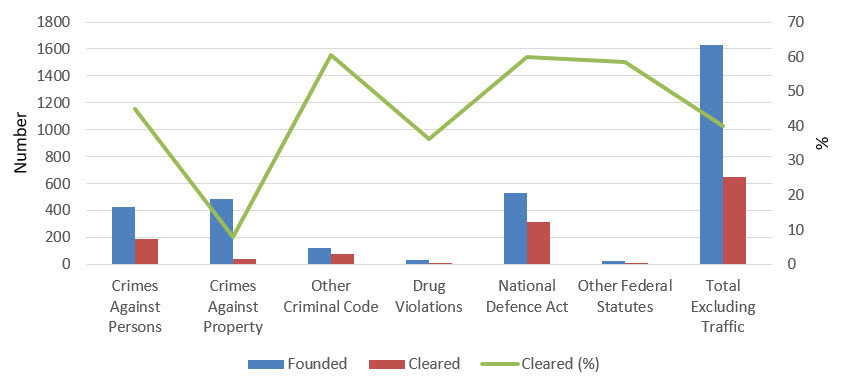
Long description
- Founded Cleared Cleared (%) Crimes Against Persons 428 192 44.9 Crimes Against Property 487 38 7.8 Other Criminal Code 124 75 60.5 Drug Violations 33 12 36.4 National Defence Act 530 317 59.8 Other Federal Statutes 24 14 58.3 Total Excluding Traffic 1626 648 39.9
Definitions
The following definitions apply to the statistical analysis of incidents.
- Calls for Service
- Incidents reported to the Military Police, by telephone or in person reporting to a Military Police Unit, Detachment or CFNIS Regional Office.
- Charged/ Subject Chargeable (CSC)
- A subject who has been charged, or where police have sufficient grounds to lay a charge against the identified individual in connection with the reported incident.
- Clearance Rate
- The clearance rate is the total number of cleared incidents divided by the number of founded incidents. (Incidents cleared by charge + Incidents cleared otherwise) Total Founded Incidents
- Cleared
- An incident is considered cleared when a CSC has been identified in connection with the incident. Files may be cleared by charge, or cleared otherwise.
- Cleared by Charge
- An incident is cleared by charge when police lay a charge, or in cases where police recommend charges in provinces or situations where Crown charge approval is required (e.g., BC, QC, NB).
- Cleared Otherwise
- An incident is cleared otherwise when police have sufficient grounds to charge a CSC in connection with the incident, however police do not lay a charge. Reasons may be discretionary (e.g., diversion), or they may be outside police control (e.g., death of accused).
- Founded Incident
- An incident is presumed founded, unless it has been deemed frivolous, vexatious or a determination that it is unfounded has been made.
- General Occurrence
- The predominant type of military police report. Incidents to which MP respond and investigate are recorded as General Occurrences.
- Street Check
A street check refers to field inquiries made by police, and is named after the SAMPIS subsystem where they are recorded. Although in some jurisdictions this term has become synonymous with “carding” the reality for the Military Police is quite different. A street check is a type of self-directed or police initiated activity. The following are examples of activities classified as street checks:
- Security patrols of defence establishments
- Access control duties under the Defence Controlled Access Area Regulations;
- RIDE Program check stops;
- Investigation of suspicious activity resulting in contact with member(s) of the public
- Unfounded
It has been determined through police investigation that the offence reported did not occur, nor was it attempted.
This designation requires a positive determination based on evidence that shows that the incident did not occur, rather than simply an absence of proof that it did occur.
Annex B: Military Police Analytics Program - Update (MPAP)
Introduction
Since the creation of the MPAP in 2019, it has been continually developing and improving its capabilities, as well as providing feedback to the chain of command to improve data quality. It continues to respond to demands for business intelligence (BI) products related to the delivery of the policing program.
The purpose of this year’s analytics annex is to highlight the progress being made in implementing some of the recommendations from the Report of the Third Independent Review of the National Defence Act; in particular, recommendations 17, 29 and 35.
Recommendations
Recommendation 17
The Canadian Forces Military Police Group and Canadian Military Prosecution Service should collect, retain and centralize data on the civil offences committed by persons subject to the Code of Service Discipline charged in either the military or civilian justice systems. The data should, at a minimum, include the number of civil offences allegedly committed by persons subject to the Code of Service Discipline which formed the basis of charges, the nature of such offences, the rationale for the determination of which system the charges were proceeded in, the time elapsed between the complaint and the completion of the trial and the outcomes of the charges, including the punishments imposed if any.
The MP employ a purpose-built commercial police records management system (RMS) known internally as the Security and Military Police Information System (SAMPIS).
At present, the system and procedures are set up to ensure that military and civil offences are tracked and whether charges are laid. Some level of analysis is possible, with inference made on the military exercising jurisdiction over civil offences based on whether or not an offence under National Defence Act s. 130 is shown on the report.
Table 1 shows the approximate annual breakdown of charge distribution between military and civilian justice systems. Further analysis should be undertaken to better understand how these figures change based upon situational factors. For instance, in 2018 the Court Martials Appeals Court (CMAC) decision in R. v. BeaudryFootnote 1 limited military jurisdiction to prosecute, followed by the decision of the Supreme Court of Canada on appeal to overturn the CMAC decision.Footnote 2
However, the response to the query and the production of the table below was a valuable exercise to prove the concept and begin developing a methodology.
Table 1: Breakdown of Cases by Justice System and Year (N = 177)
| Year | Military | Civil | Undetermined | Total | |||
|---|---|---|---|---|---|---|---|
| 2021Footnote a | 7 | 23% | 22 | 71% | 2 | 6% | 31 |
| 2020 | 21 | 48% | 23 | 52% | 0 | 0% | 44 |
| 2019 | 30 | 54% | 26 | 46% | 0 | 0% | 56 |
| 2018 | 13 | 28% | 32 | 70% | 1 | 2% | 46 |
| TOTAL | 71 | 40% | 103 | 58% | 3 | 2% | 177 |
Implementation Plan
Through 2022, the MP will be formalizing the use of the Arrest/Court subsystem, with a goal of full implementation by end of December 2022. The first step is to ensure the information is being collected correctly and accurately in a manner that will facilitate extraction and analysis.
Recommendation 29
The Canadian Forces Provost Marshal, in his annual reports, should provide data on the length of military police investigations. If this data indicates that problems of delays in investigations persist or re-emerge, the Canadian Forces Provost Marshal should re-assess the effectiveness of the measures implemented in 2018 and 2019 and consider the implementation of additional reforms.
In order to provide meaningful data on the length of investigations, the MPAP has begun analysing the problem and has reached out to other police agencies. No police agency has so far been identified that produces public facing data on the length of investigations. In reporting on the length of investigations, MPAP has determined that it would be most useful to provide the minimum, maximum, median and mean. This would permit a longitudinal evaluation of investigation length that, when compared with other data, can help build a picture of the health of the institution. For example, an increase in reports and investigation length, mapped against a steady number of investigators could indicate that there are insufficient resources committed to the workload. However, this analysis is in its infancy and requires more development.
Table 2 is an initial attempt at generating results that responded to the recommendation.Footnote 3 Focused solely on sexual misconduct, this table shows a yearly comparison on the length of investigations, broken down between cases where charges were laid, and cases that were cleared otherwise. Where it becomes difficult to interpret these figures is in understanding the uniquely military context. For instance, a sexual assault could be reported by a victim for an assault that took place a year earlier on training in another province, with a suspect who is in a third location. This may involve substantial travel and coordination to obtain evidence and conduct interviews. Another consideration that must be taken into account is the time elapsed between the incident and the reporting. As the median and mean include all files reported in that year for the stated offence types, without further concurrent analysis on factors such as geography and time elapsed since the incident, it is impossible to draw conclusions from these figures alone.
Implementation Plan
The MPAP will continue to liaise with other police agencies and StatCan to develop the methodology for analysis.
Table 2: Length of Investigation for Cleared Sexually Based Offences in 2015-2020 (N= 518)
| - | - | Files Cleared | |||||||||
|---|---|---|---|---|---|---|---|---|---|---|---|
| - | - | Charged/Charges Recommended | Cleared Otherwise | ||||||||
| - | - | - | Length of Investigation (Days) | - | Length of Investigation (Days) | ||||||
| Year | Type | # Files | Min | Max | Median | Mean | # Files | Min | Max | Median | Mean |
| 2015 | SA | 31 | 0 | 664 | 46 | 110 | 13 | 0 | 357 | 41 | 72 |
| SC | 6 | 0 | 823 | 155 | 238 | 2 | 72 | 155 | 114 | 114 | |
| OT | 4 | 2 | 302 | 27 | 90 | 7 | 0 | 118 | 31 | 38 | |
| Total | 41 | 0 | 823 | 51 | 127 | 22 | 0 | 357 | 186 | 224 | |
| 2016 | SA | 56 | 0 | 1254 | 207 | 213 | 21 | 1 | 335 | 6 | 66 |
| SC | 5 | 3 | 470 | 278 | 248 | 3 | * | * | * | * | |
| OT | 5 | 89 | 299 | 167 | 167 | 2 | * | * | * | * | |
| Total | 66 | 0 | 1254 | 202 | 212 | 26 | 1 | 353 | 8 | 80 | |
| 2017 | SA | 52 | 0 | 1542 | 140 | 263 | 15 | 1 | 1066 | 33 | 138 |
| SC | 7 | 28 | 826 | 261 | 363 | 2 | * | * | * | * | |
| OT | 6 | 7 | 188 | 71 | 77 | 1 | * | * | * | * | |
| Total | 65 | 0 | 1542 | 139 | 256 | 18 | 1 | 1066 | 0 | 0 | |
| 2018 | SA | 59 | 0 | 1162 | 169 | 265 | 38 | 0 | 325 | 2 | 45 |
| SC | 6 | 0 | 765 | 151 | 235 | 2 | * | * | * | * | |
| OT | 4 | 6 | 134 | 82 | 76 | 4 | 0 | 9 | 2 | 3 | |
| Total | 69 | 0 | 1162 | 159 | 251 | 44 | 0 | 325 | 2 | 43 | |
| 2019 | SA | 53 | 0 | 740 | 169 | 202 | 29 | 0 | 722 | 8 | 68 |
| SC | 5 | 0 | 589 | 21 | 136 | 3 | * | * | * | * | |
| OT | 10 | 0 | 385 | 35 | 105 | 5 | 0 | 150 | 1 | 31 | |
| Total | 68 | 0 | 740 | 103 | 183 | 37 | 0 | 722 | 6 | 67 | |
| 2020 | SA | 37 | 0 | 596 | 173 | 194 | 11 | 0 | 312 | 171 | 157 |
| SC | 5 | 2 | 377 | 20 | 130 | 1 | * | * | * | * | |
| OT | 8 | 9 | 468 | 147 | 159 | - | - | - | - | - | |
| Total | 50 | 0 | 596 | 171 | 182 | 12 | 0 | 312 | 135 | 149 | |
| 2015-2020 Combined |
SA | 288 | 0 | 1542 | 154 | 217 | 127 | 0 | 1066 | 14 | 77 |
| SC | 34 | 0 | 826 | 142 | 234 | 13 | 1 | 353 | 93 | 141 | |
| OT | 37 | 0 | 468 | 75 | 116 | 19 | 0 | 150 | 8 | 24 | |
| Total | 359 | 0 | 1542 | 140 | 208 | 159 | 0 | 1066 | 15 | 76 | |
* Information withheld due to the small number of incidents. These values are incorporated into the subtotals for the year and category.
SA: Sexual Assault; SC: Sexual Crimes against Children; OT: Other Sexual Crimes (e.g., non-consensual distribution of intimate images).
Recommendation 35
The Canadian Forces Provost Marshal and the Judge Advocate General should provide in their future annual reports data and assessments on arrests and pre-trial custody. The data should, at a minimum, include the number of arrests, the status of the persons making the arrest and the persons under arrest, the nature of the alleged service offences, the length of custody, and information pertaining to the particular communities with which the persons arrested or detained identified.
The CFPM has directed MPAP to come up with a plan to collect intersectionality data in such a way that it helps to gain a better understanding of our own institution.
The collection of intersectionality data is somewhat problematic, as it relies on self-identification. Although a subject, victim or witness may appear outwardly to belong to a particular ethnic group for instance, this assumption cannot be made by the police. Rather, it is incumbent upon the client or justice system participant to determine if they wish to provide this information.
Implementation Plan
The more challenging aspect of this is to determine what data to collect, how to collect it, and how to communicate the intent of the data collection to justice system participants. Furthermore, while race/ethnicity and gender identity are captured by SAMPIS, sexual orientation and culture are not. And presently the race/ethnicity is captured by StatCan only for the purpose of identifying Indigenous individuals. Consultation with StatCan is needed to ensure that our data collection dovetails neatly with future changes to the UCR Survey, to prevent data conflicts and errors. Similarly, data collection on sexual orientation must be synchronized with other police agencies and experts to ensure consistency across the policing community. Most importantly however, will be ensuring that our intersectionality data collection processes are subjected to rigorous Gender Based Analysis Plus (GBA+), in consultation with the Director of Human Rights and Diversity and the Defence Advisory Groups.
Conclusion
The implementation of these recommendations will not only facilitate future review and improve transparency and accountability, but provide valuable insight into the effectiveness of the MP. The MP hold large amounts of data and as we move forward with an ambitious analytics program, we expect to see improved metrics and better informed decision making.
Annex C: The MP in Numbers
| MP Regular Force Personnel | Authorized (Preferred Manning Level) | Actual (Trained Effective Strength) |
|---|---|---|
| Officers | 188 | 198 |
| Non-Commissioned Members (NCM/NCO) | 1 291 | 1 115 |
| Total | 1 479 | 1 313 |
| MP Reserve Force Personnel | Authorized (Preferred Manning Level) | Actual (Trained Effective Strength) |
|---|---|---|
| Officers, NCOs and NCMs | NCM 589 / MPO 47 Total 636 | NCM 226 / MPO 41 Total 267 |
| MP Group Gender Distribution | Officer | NCM/NCO |
|---|---|---|
| Female (Regular Force) | MP Officers 25% (CAF 16%) | MP 15% (CAF 16%) |
| Male (Regular Force) | MP Officers 75% (CAF 84%) | MP 85% (CAF 84%) |
| Female (Reserve Force) | MP Officers 17% (CAF 17%) | MP 15% (CAF 16%) |
| Male (Reserve Force) | MP Officers 83% (CAF 83%) | MP 85% (CAF 84%) |
Annex D: Map – CF MP Gp in Canada

Long description
A map of Canada illustrates the cities in each province where military police group units are located. They are:
- The Naval Military Police Group has units in Nanoose Bay and Esquimalt in British-Colombia (B.C.); Borden and Ottawa in Ontario (Ont.); St. John’s Newfoundland and Labrador (N.L.); and Halifax, Nova-Scotia (N.S.).
- The Army Military Police Group has units in Chilliwack B.C.; Calgary, Edmonton, Suffield and Wainwright in Alberta (Alta.); in Shilo Manitoba (Man.); Meaford, London, Toronto, Kingston, Petawawa and Ottawa in Ont.; Saint-Jean-sur-Richelieu, Valcartier and Montréal in Que.; Gagetown New-Brunswick (N.B.); and Sackville in N.S.
- The Air Force Military Police Group has units in Comox, B.C.; Cold Lake in Alta.; Moose Jaw and Dundurn in Saskatchewan (Sask.); Winnipeg in Man.; Trenton, North Bay and Ottawa in Ont.; Bagotville in Que.; Greenwood in N.S.; and, Gander and Goose Bay in N.L.
- The Military Police Reserve Force has units in Vancouver B.C.; Calgary Alta.; Winnipeg Man.; London, Toronto and Ottawa in Ont.; Québec city, Saguenay and Montréal in Que.; Sackville N.S.; and, Moncton N.B.
- The Canadian Forces National investigation Service has units in Victoria B.C.; Edmonton Alta.; Borden and Ottawa in Ont.; Valcartier in Que.; and Halifax N.S.
- The Canadian Forces Military Police Group Headquarters is located in Ottawa, Ont.
Annex E: Map – MP Support to CAF Named Operations

Long description
A political map of the world illustrates in which military operations are Canadian military police personnel deployed. They are:
- Operation Distinction in Ottawa, Ont. – National Centry Program
- Operation Reassurance in the city of Adazi in Latvia and the city of Constata in Romania
- Operation Unifier in the cities of Kiev and Yavoriv in Ukraine.
- Operation AEGIS in Kabul, Afghanistan.
- Operation Calumet in the cities of Egypt El Gorah and Sharm-El-Sheik in Egypt.
- Op REASSURANCE
- Joint Task Force-Impact in the cities of Ahmed El Jaber, Ali Al Salem in Kuwait, and the cities of Bagdad, Erbil in Iraq.
- Op CARIBBE, Belize
- Op LENTUS, BC
- Operation Presence in Dakar, Senegal GAO and Mali
134 Military police personnel were spread over 9 missions. 333 Military Police personnel were on high readiness in support of 2 missions.
Annex F: Map – Military Police Security Service (MPSS) Disposition

Long description
A political map of the world illustrates in which cities Canadian military police detachments and/or personnel are present. They are:
- New York, United States
- Washington, United States
- Mexico City, Mexico
- Kingston, Jamaica
- Port-au-Prince, Haiti
- Caracas, Venezuela
- Bogota, Columbia
- Lima, Peru
- Brasilia, Brazil
- Athens, Greece
- Rome, Italy
- Paris, France
- London, United Kingdom
- Brussels, Belgium
- Belgrade, Serbia
- Berlin, Germany
- Warsaw, Poland
- Vienna, Austria
- Moscow, Russia
- Kiev, Ukraine
- Islamabad, Pakistan
- New Delhi, India
- Beijing, China
- Tokyo, Japan
- Manila, Philippines
- Bangkok, Thailand
- Jakarta, Indonesia
- Dhaka, Bangladesh
- Kuwait City, Kuwait
- Erbil, Iraq
- Cairo, Egypt
- Ankara, Turkey
- Istanbul, Turkey
- Riyadh, Saudi Arabia
- Ramallah, West Bank
- Colombo, Sri Lanka
- Nairobi, Kenya
- Addis Ababa, Ethiopia
- Pretoria, South Africa
- Khartoum, Sudan
- Kinshasa, Congo
- Abuja, Nigeria
- Lagos, Nigeria
- Tunis, Tunisia
- Bamako, Mali
- Algiers, Algeria
- Dakar, Senegal
- Tel Aviv, Israel
- Rabat, Morocco
- Amman, Jordan
- Beirut Lebanon
A total of 47 detachments and 80 personnel are present across the globe.

